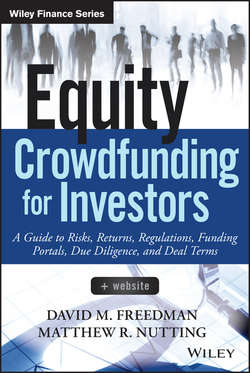Читать книгу Equity Crowdfunding for Investors - Matthew R. Nutting - Страница 18
Chapter 1
The Foundations of Online CrowdfundingA History of Rewards-, Donation-, and Debt-Based Crowdfunding Platforms
But the Internet Changes Some Things
ОглавлениеYou have probably heard of Joseph Pulitzer, more likely because of the Pulitzer Prize than his 1885 civic crowdfunding project. You have probably not heard of Brian Camelio, one of the pioneers of modern crowdfunding. A Boston musician and computer programmer, Camelio attended a West African dance show in 2000 and was amazed (and inspired) when people in the audience got up out of their seats, ran up to the stage, and literally threw money at the dancers.
It occurred to Camelio that this method of funding artists provided a solution to the growing problem of piracy in the music industry. That is, once a digital version of a recording is published on the Internet, it's too easy for pirates to download it illegally, depriving the composer, recording artist, and/or producer of revenue that they deserve. Throwing money at a performing artist on stage certainly solves the problem on a very small scale, but what about the thousands of recording artists who haven't yet performed in public?
Camelio developed a website where fans of a musician can figuratively throw money at the artist, in effect prepurchasing the recording (or other reward), before their digital recording was released. He named the site ArtistShare. Launched in 2003, ArtistShare's first crowdfunding project (which the ArtistShare team called “fan-funding” then) was Maria Schneider's jazz album Concert in the Garden. Through the funding platform, Schneider's fans could contribute money in specified amounts to help her compose and produce the album. Fans who contributed $9.95, for example, got to be among the first customers to download the album legally upon its release in 2004. Fans who contributed $250 or more (in addition to receiving an album download) were listed, in the booklet that accompanied the album, as Bronze Participants who “helped to make this recording possible.” One fan, who contributed $10,000, was (as specified in the ArtistShare campaign) listed as an executive producer and invited to dine with the artist at a New York restaurant; another, who contributed $18,000, went bird-watching with Schneider in Central Park, among other rewards.
Schneider's ArtistShare campaign raised about $130,000, although neither Schneider nor Camelio is willing to disclose the number of contributors.12 That funding enabled the artist to compose the music, pay her musicians, rent a large recording studio, and produce and market the album (it was sold exclusively through the ArtistShare website), which won a 2005 Grammy Award for best large jazz ensemble album.
ArtistShare still supports many musicians and composers in various genres, and also a small number of photographers and filmmakers, each of whom must submit an application and be selected before they can appear on the platform – in other words, the site is curated. The site enables artists to “share” their creative process with fans through innovative content management tools. Artists typically offer, in exchange for funding, such rewards as advance copies of CDs, “VIP access” to performances (e.g., front-row seats or backstage passes), private concerts, attendance at rehearsals and recording sessions, getting your picture taken with the artist, being named as a producer, and other perks, in addition to the basic (legal) digital download. When Schneider won another Grammy in 2008, for her work on the Sky Blue album, one of her biggest ArtistShare contributors was named executive producer and attended the Grammy Award ceremony with her.
When Schneider embarked on her groundbreaking crowdfunding campaign, before the fan-funding concept had been tested, much less proven, “a lot of other musicians and people in the recording industry told me I was crazy to abandon the traditional model of production and distribution,” she says. The key to her success on ArtistShare was her devoted fan base, on which she knew she could rely. The funding platform allows connection and communication between artist and fans that the traditional business model could not. The success of crowdfunding for Schneider went beyond dollars to “long-term relationships with my fans,” she says.
In all ArtistShare campaigns, the artists keep 85 percent of the funds generated and retain full ownership of their copyrights and master tapes – a significant departure from the traditional music industry. The funding platform keeps 15 percent. The platform also earns revenue on sales of music-related merchandise.
By the end of 2013, ArtistShare had funded music projects that resulted in four more Grammy Awards in addition to Schneider's two.
12
Based on e-mail correspondence with Maria Schneider and the ArtistShare publicity team, October 2013.
